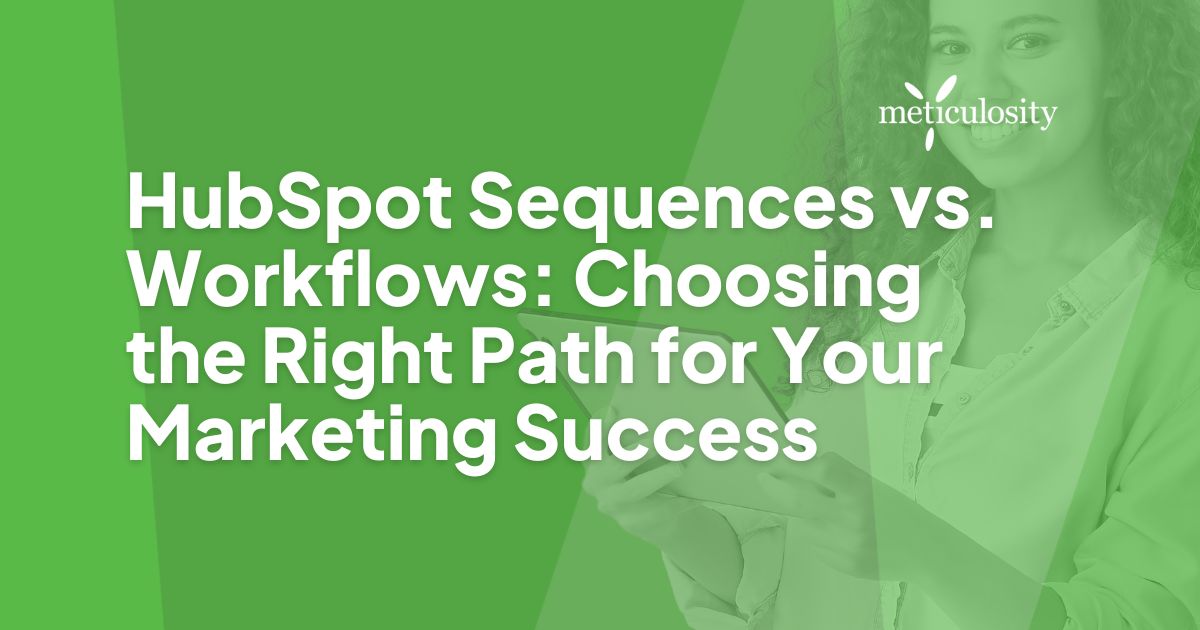Diving headfirst into the vast ocean of email automation can feel a bit intimidating, especially when it comes down to choosing between HubSpot's Sequences and Workflows.
But here's an interesting fact - did you know that 91% of marketers consider automation a real game-changer for success? Through extensive research, it has become apparent that both tools offer unique advantages.
This article aims to shed light on the contrasts between these two elements and equip you with strategic insights that will simplify your decision-making process.
Key Takeaways
- HubSpot Sequences and Workflows are powerful email automation tools that offer unique advantages for marketers.
- Sequences are used for sending a series of personalized emails to one person at a time, while Workflows automate actions for multiple people all at once.
- Sequences are ideal for nurturing leads through automated emails, while Workflows streamline complex processes and sales tasks.
- Choosing between Sequences and Workflow depends on the complexity of your processes, the level of personalization needed, and your specific marketing or sales goals.
Understanding HubSpot's Email Automation Tools
Sequences and Workflows are two powerful email automation tools offered by HubSpot.
Sequences and Workflows: What's the Difference?
Sequences and workflows are both great in HubSpot, but they have different uses. You use sequences to send a series of emails to one person at a time. It is like having a one-to-one chat with someone.
Workflows are for lots of people all at once. They can do more than send emails, like updating info or adding delays. Think of it as your big boss who handles many tasks together.
How they work
HubSpot has two great tools called Sequences and Workflows. They help you send emails to your leads. Here is how it happens: You first set up rules or 'triggers'. These rules tell the system when to send an email.
For example, if a lead visits your website, that visit can be a trigger. Once it happens, an email goes out to that person right away! You can even set delays in between emails and decide what action should take place next based on how they respond.
It's like having your robot helper doing tasks for you! HubSpot ensures this process runs smoothly so you can focus more on big ideas and less on small tasks. It does save time!
Looking to optimize HubSpot for your business? Learn how to improve here.
Comparing Sequences and Workflows
Sequences and Workflow differ in terms of triggers, actions, delays, and conditions used for automation.
Triggers, actions, delays, and conditions
We want to show you something about triggers, actions, delays, and conditions in HubSpot's Sequences and Workflows.
- Triggers start a sequence or workflow. These can include a new lead sign-up or a clicked email link.
- Actions occur after the trigger—for example, sending an email or updating contact info.
- Delays give us time between actions. We might wait a day before sending the next email in a sequence.
- Conditions help us choose who gets what action. They use info like job titles or past purchases to pick out contacts.
Contact-based vs. property-based automation
As a marketer or business professional, understanding the difference between contact-based and property-based automation is key. Contact-based automation is triggered by changes or updates to a contact's record, while property-based automation is triggered by changes in a property's value, like lead score or lifecycle stage.
|
Aspect |
||
|
Trigger |
Changes or updates in a contact's record, such as job title, industry, or company size. |
Changes in the value of a property like lead score, lifecycle stage, or conversion event. |
|
Use Case |
Useful for personalizing communication with individual contacts based on specific changes or updates in their records. |
Useful for targeting a specific group of contacts with similar attributes or behaviors. |
|
Example |
You can create a sequence that sends a personalized email to a contact once they've been assigned a new job title. |
You can set up a workflow that automatically sends a follow-up email to leads who have reached a certain lead score. |
Selecting between these automation types often depends on your specific marketing or sales goals and the level of personalization needed for your communications.
Suitable for marketing and sales teams
As a marketer or sales professional, you'll be happy to know that both HubSpot Sequences and Workflows are suitable tools for your needs. Sequences are great for nurturing leads through automated emails and improving follow-up with potential customers.
They allow you to send personalized messages and stay engaged with your leads at the right time. On the other hand, workflows are more suited for complex processes and streamlining the sales process.
You can use them to automate actions based on different triggers and conditions, making your work more efficient. So whether you're focused on marketing or sales, both Sequences and Workflows have their strengths in helping you achieve success in your campaigns and lead nurturing efforts.
Choosing the Right Tool for Your Needs
When choosing between Sequences and Workflow, consider the complexity of your processes and whether you need to nurture leads or streamline the sales process.
Complex processes: Use workflows
For complex processes in your marketing or sales strategies, it's best to use HubSpot Workflows. With Workflows, you can automate a series of actions and decisions based on specific triggers and conditions.
This allows you to create customized journeys for your leads or customers, ensuring they receive the right messages at the right time. Whether it's lead segmentation, lead scoring, or advanced nurturing sequences, Workflows provide the flexibility and customization needed to handle complex tasks effectively.
You'll be able to streamline your processes and save time while delivering personalized experiences that engage your audience.
Nurturing leads: use Sequences
To effectively nurture leads, Sequences in HubSpot are the ideal tool for the job. With Sequences, you can automate personalized email communication with your leads to build a strong relationship.
You can create a series of emails that are automatically sent out at specific intervals, ensuring consistent engagement without needing constant manual effort. By tailoring your messages based on the lead's behavior and interests, you increase the chances of conversion and customer loyalty.
Sequences make it easy to provide valuable content, follow up on inquiries, and keep your leads engaged throughout their buyer's journey.
Consider your business goals
To choose between HubSpot Sequences and Workflows, it's important to consider your business goals. Think about what you want to achieve with your email automation. If you have complex processes involving multiple steps and decision-making points, Workflows might be the better choice for you.
It allows for more customization and flexibility in creating automated workflows based on specific triggers, actions, delays, and conditions.
On the other hand, if your main focus is nurturing leads through personalized communication, Sequences can be a great option. It enables you to create automated emails sent out at predetermined intervals, helping you stay engaged with your leads and provide them with relevant content.

Benefits of Using HubSpot's Automation Tools
HubSpot's automation tools save time, improve efficiency, and allow for personalized communication with leads. With the ability to integrate with other HubSpot tools, these automation features are essential for any marketing or sales team.
Read on to discover how to maximize the benefits of using HubSpot's Sequences and Workflows in your business.
Saves time and improves efficiency
Using HubSpot's automation tools, such as Sequences and Workflows, can save you precious time and enhance your marketing efficiency. With automated processes in place, you don't have to send individual emails or perform repetitive tasks manually.
Instead, the tools handle these tasks for you automatically based on the triggers and actions you set up. This frees up your time to focus on other important aspects of your marketing strategy and allows you to reach out to leads more effectively.
By automating certain tasks, you can streamline your workflow and ensure that everything runs smoothly without wasting valuable time or resources.
Personalized communication with leads
You can create personalized communication with your leads by using HubSpot's automation tools like Sequences and Workflows. These tools allow you to send targeted emails based on specific triggers and actions, such as a lead opening an email or visiting a certain page on your website.
With Sequences, you can set up a series of automated emails customized to each contact's behavior and interests. This helps you nurture leads by providing them with relevant content at the right time.
Workflows, on the other hand, enable you to automate complex processes and tailor communication based on different conditions. By personalizing your communication with leads, you can build stronger relationships and increase engagement for better marketing success.
Integrating with Other HubSpot Tools
Sequences and Workflows seamlessly integrate with other HubSpot tools, such as CRM, to provide a comprehensive automation solution for your marketing and sales teams. Discover how these powerful features can enhance your overall strategy by reading more.
How Sequences and Workflows work with other tools
Sequences and Workflow in HubSpot are not standalone tools. They seamlessly integrate with other HubSpot tools, enhancing functionality and creating a cohesive marketing ecosystem. Here's how Sequences and Workflows work with other tools:
- CRM Integration: Both Sequences and Workflows can access and utilize the data stored in your HubSpot CRM, allowing you to personalize your automation based on contact properties, behavior, and interactions.
- Email Marketing: Sequences and Workflows can be used with HubSpot's Email Marketing tool to send automated and personalized emails to contacts at specific stages of their buyer journey or based on certain actions they take.
- Lead Capture Forms: By connecting Sequences or Workflows with HubSpot's forms tool, you can automatically enroll new leads into a sequence or trigger a workflow when someone submits a form on your website.
- Content Creation: You can use Sequences and Workflows to automate the delivery of content assets, such as ebooks or whitepapers, through HubSpot’s Content Management System (CMS), ensuring that leads receive relevant information at the right time.
- Analytics: Both tools provide valuable insights into the performance of your automated campaigns. You can track email open rates, click-through rates, conversion rates, and more to measure the effectiveness of your marketing efforts.
- Salesforce Integration: If you use Salesforce as your CRM system instead of HubSpot's CRM, Sequences and Workflows can still be integrated to streamline your marketing processes by automating tasks within Salesforce based on certain triggers or actions in HubSpot.
Tips for Maximizing the Benefits of HubSpot's Automation
Regularly review and optimize your sequences and workflows to ensure they align with your business goals and effectively engage your leads.
Regularly review and optimize your sequences and workflows
To make the most out of HubSpot's automation tools, it's important to review and optimize your sequences and workflows regularly. Here are some tips to help you achieve that:
- Monitor performance metrics: Monitor key performance indicators (KPIs) such as open rates, click-through rates, and conversion rates. This will give you insights into how your sequences and workflows are performing.
- Analyze engagement data: Look at the level of engagement your leads are showing with your automated emails. Are they opening and clicking on your emails? Are they taking the desired actions? Use this data to identify areas for improvement.
- Test variations: Experiment with different subject lines, email content, and call-to-action buttons to see what resonates best with your audience. A/B testing can help you find the most effective approach.
- Optimize timing and frequency: Test different send times and intervals between emails to determine when your leads are most likely to engage. Avoid bombarding them with too many emails too quickly, which can lead to unsubscribes or disengagement.
- Review automation rules: Ensure that your triggers, actions, delays, and conditions are still relevant and aligned with your business goals. Update them as needed based on feedback from sales teams or changes in customer behavior.
- Personalize where possible: Use dynamic personalization tokens to tailor your emails based on each recipient's information or behavior history. This can help increase engagement and drive conversions.
- Segment your audience: Divide your contacts into smaller groups based on specific criteria such as industry, persona, or lifecycle stage. You can improve relevance and engagement by sending more targeted messages to each segment.
- Seek feedback from sales teams: Regularly consult with sales teams to understand their needs and challenges regarding lead nurturing and follow-up processes. Their input can inform adjustments to your sequences and workflows.
Test and refine to improve results
Testing and refining your sequences and workflows can help you improve your marketing results as a marketer or business professional. Here are some tips to consider:
- Experiment with different triggers: Try using different triggers to start your sequences or workflows—test which ones result in the highest engagement and adjust accordingly.
- Fine-tune your actions: Evaluate the actions you include in your automation tools. Are they helping you achieve your goals? Test different actions to see what generates the best response from your audience.
- Adjust delays: Timing is crucial when it comes to email automation. Experiment with different delays between actions to find the optimal timeframe for your audience.
- Refine conditions: Conditions allow you to specify who should continue through a sequence or workflow based on specific criteria. Test different conditions to ensure you send the right messages to the right people at the right time.
- Monitor performance metrics: Keep an eye on important metrics like open rates, click-through rates, and conversions. Analyze this data regularly and make adjustments based on what's working best.
- Split test variations: Split testing allows you to compare two versions of a sequence or workflow to determine which one performs better. Test things like subject lines, call-to-actions, and content variations.
- Seek feedback: Don't be afraid to ask for feedback from colleagues or other professionals in your field. Their insights may help you identify areas you may have missed for improvement.

Conclusion
In conclusion, understanding the differences between HubSpot Sequences and Workflows is crucial for choosing the right tool to achieve marketing success. While Workflows are ideal for complex processes and nurturing leads, Sequences excel in personalized communication.
By considering your business goals and integrating these automation tools with other HubSpot features, you can save time, improve efficiency, streamline sales processes, and nurture leads effectively.
Click here to learn more about HubSpot marketing.
FAQs
1. What is the difference between HubSpot Sequences and Workflows, and when should I use each?
-
HubSpot Sequences: Sequences are primarily designed for sales outreach and engagement. They allow you to automate a series of personalized emails and tasks for individual contacts or lists. Sequences are ideal for streamlining and automating the sales follow-up process, ensuring timely and relevant communication with leads.
-
HubSpot Workflows: Workflows, on the other hand, are broader automation tools that can be applied across marketing, sales, and customer service. Workflows are designed to automate a series of actions based on specific triggers, such as form submissions, lead scoring changes, or contact property updates. Workflows are versatile and can be used for various automation scenarios beyond sales outreach, such as lead nurturing, internal notifications, or customer onboarding.
2. How do HubSpot Sequences and Workflows handle automation differently?
-
HubSpot Sequences: Sequences focus more on automating the engagement process with individual contacts, primarily in a sales context. They often include a series of emails, tasks, and follow-up actions tailored to the specific needs of a sales representative or team. Sequences are linear and driven by the desired cadence of communication.
-
HubSpot Workflows: Workflows provide a broader scope of automation. They are rule-based and can trigger actions based on various conditions. Workflows can be applied to various objects, including contacts, companies, deals, and tickets. They are versatile, allowing you to automate complex processes by defining triggers, conditions, and subsequent actions.
3. Can I use HubSpot Sequences within HubSpot Workflows?
Yes, you can integrate HubSpot Sequences into HubSpot Workflows to create more dynamic and complex automation scenarios. This integration allows you to leverage Sequences' personalized engagement within the broader workflow context. For example, you might enroll contacts in a Sequence as part of a larger workflow that includes additional actions and conditions beyond email engagement.
4. In what scenarios is using HubSpot Sequences over Workflows more beneficial, and vice versa?
-
Use HubSpot Sequences when:
- Engaging in personalized sales outreach with a specific set of contacts.
- Following up with leads in a structured and timed sequence.
- Automating tasks and emails for individual sales representatives.
-
Use HubSpot Workflows when:
- Automating marketing campaigns and lead nurturing.
- Managing internal processes, such as lead scoring changes or task assignments.
- Implementing complex automation scenarios that involve multiple actions, conditions, and triggers.
While Sequences are tailored for sales engagement, Workflows offer a broader range of automation capabilities and are suitable for various marketing, sales, and service-related processes.







